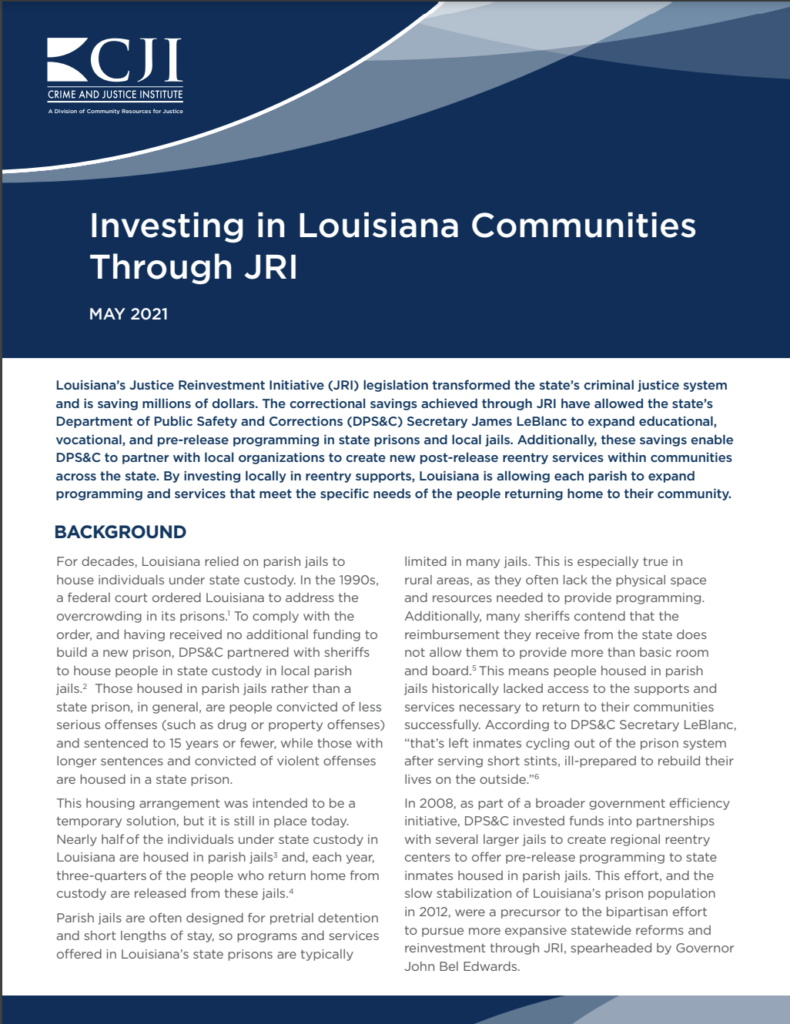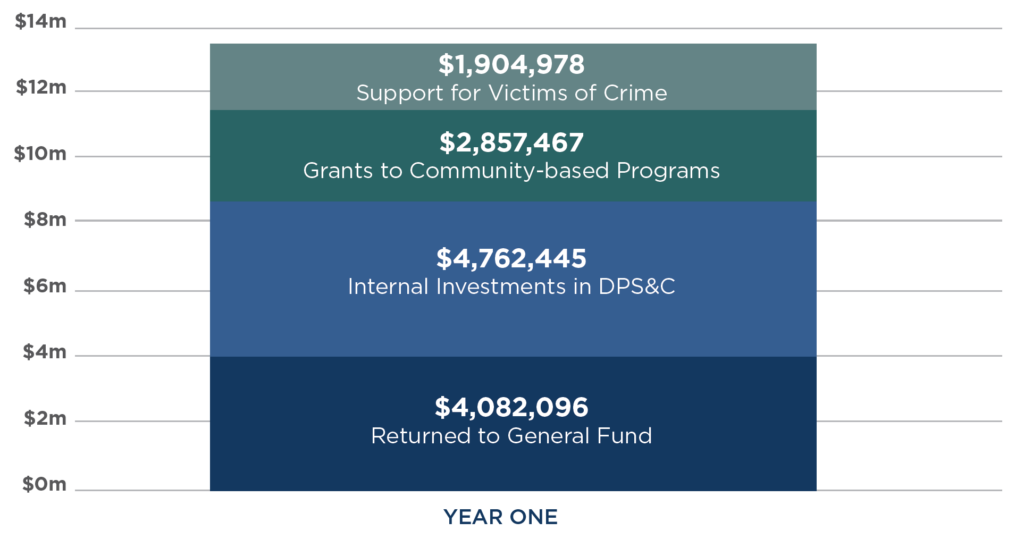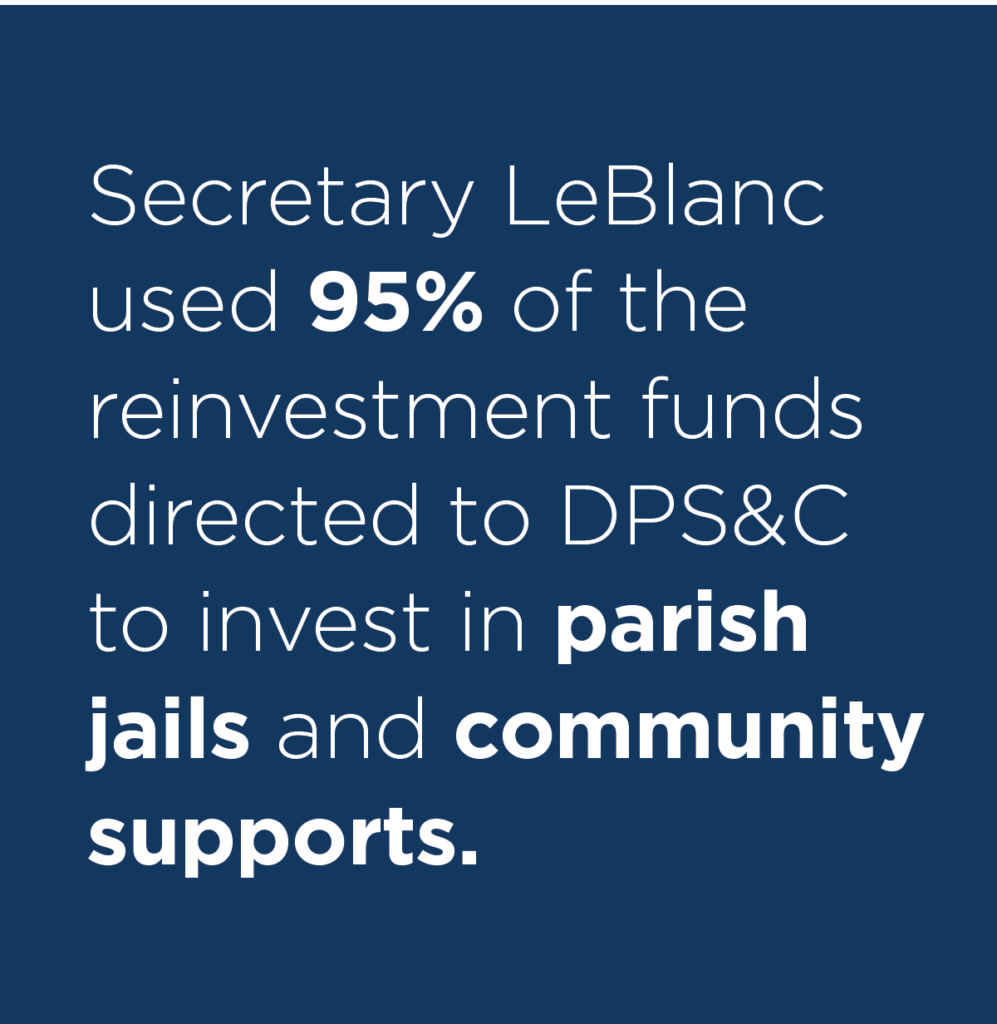Investing in Louisiana Communities Through JRI

Louisiana’s Justice Reinvestment Initiative (JRI) legislation transformed the state’s criminal justice system and is saving millions of dollars.
The correctional savings achieved through JRI have allowed the state’s Department of Public Safety and Corrections (DPS&C) Secretary James LeBlanc to expand educational, vocational, and pre-release programming in state prisons and local jails. Additionally, these savings enable DPS&C to partner with local organizations to create new post-release reentry services within communities across the state. By investing locally in reentry supports, Louisiana is allowing each parish to expand programming and services that meet the specific needs of the people returning home to their community.
Background
For decades, Louisiana relied on parish jails to house individuals under state custody. In the 1990s, a federal court ordered Louisiana to address the overcrowding in its prisons.1 To comply with the order, and having received no additional funding to build a new prison, DPS&C partnered with sheriffs to house people in state custody in local parish jails.2 Those housed in parish jails rather than a state prison, in general, are people convicted of less serious offenses (such as drug or property offenses) and sentenced to 15 years or fewer, while those with longer sentences and convicted of violent offenses are housed in a state prison.
This housing arrangement was intended to be a temporary solution, but it is still in place today. Nearly half of the individuals under state custody in Louisiana are housed in parish jails3 and, each year, three-quarters of the people who return home from custody are released from these jails.4
Parish jails are often designed for pretrial detention and short lengths of stay, so programs and services offered in Louisiana’s state prisons are typically
limited in many jails. This is especially true in rural areas, as they often lack the physical space and resources needed to provide programming. Additionally, many sheriffs contend that the reimbursement they receive from the state does not allow them to provide more than basic room and board.5 This means people housed in parish jails historically lacked access to the supports and services necessary to return to their communities successfully. According to DPS&C Secretary LeBlanc, “that’s left inmates cycling out of the prison system after serving short stints, ill-prepared to rebuild their lives on the outside.”6
In 2008, as part of a broader government efficiency initiative, DPS&C invested funds into partnerships with several larger jails to create regional reentry centers to offer pre-release programming to state inmates housed in parish jails. This effort, and the slow stabilization of Louisiana’s prison population in 2012, were a precursor to the bipartisan effort to pursue more expansive statewide reforms and reinvestment through JRI, spearheaded by Governor John Bel Edwards.
Reentry-Focused Investments in Communities
In 2015, Louisiana lawmakers created the Louisiana Justice Reinvestment Task Force, kicking off the state’s commitment to a data-driven process to reduce corrections spending, expand evidence based practices, and reinvest savings into strategies to reduce recidivism. The Task Force released a report detailing its findings and recommendations in 2017. The state legislature turned these recommendations into a package of ten bills designed to promote public safety and make better use of correctional dollars, which Governor Edwards signed into law in June 2017. Once those new policies went into effect, Louisiana began to see sizable declines in its correctional costs while public safety metrics held steady.7 Act 261, included in the policy package, required that 70% of any savings resulting from the implementation of JRI policies be reinvested into four areas: support for victims of crime, grants to community-based programs, internal investments in DPS&C, and investments in the Office of Juvenile Justice (starting in year 2).
The graph below shows the breakdown of the amounts for each reinvestment area in the first year.8 Most notably, the state doubled down on local investments. In addition to the nearly $2.9 million allocated for grants to community-based providers, Secretary LeBlanc directed 95% of the $4.8 million newly available to DPS&C be invested locally in the five communities to which most incarcerated people return.9 In doing so, he was ensuring the state’s investment went to the communities most in need of reentry support.
First Year Reinvestment Amounts

Expanding Reentry Resources in Parish Jails
In the last two years, Secretary LeBlanc redirected a significant portion of the reinvestment funding earmarked for investments into DPS&C to parish jails so they could expand reentry preparation and make more resources available for people in state custody held in their jails. DPS&C began helping local jails expand their programming options in 2014 by hiring Transition Specialists and creating Regional Reentry Programs at the local level. These efforts have since been bolstered by JRI reinvestment funding.
In 2014, the DPS&C expanded the reentry programing and services provided in jails by hiring 20 Transition Specialists, each assigned to a parish jail housing people serving state sentences.10 Transition Specialists conduct risk and needs assessments, provide instruction to help people succeed upon reentry (i.e., Thinking for a Change, anger management, substance use education, money management, parenting preparation, and the 100-hour pre-release curriculum), and help individuals create a plan to guide their transition back into the community.
In addition, over the last six years, DPS&C established 11 local reentry programs and created a pre-release curriculum that individuals complete prior to returning home.11 Designed for people who are approximately one year from release or in a Transitional Work program assignment, the Regional Reentry Programs provide participants with a standardized 100-hour pre-release course, two forms of identification, housing and employment plans, and connections to resources available in the community. These Regional Reentry Programs and the pre-release curriculum prepare people for reentry and ensure they are ready to return home. In addition to increasing overall access to critical reentry programming, the creation of local reentry programs enables DPS&C to house more individuals closer to their parish of residence, which makes it easier to connect returning citizens to the supports and resources that will be available to them upon their release.

Louisiana’s Regional Reentry Programs Provide Participants With:

In 2018, one year after the passage of Louisiana’s JRI legislative package, DPS&C reinvested funds earmarked for internal use instead to expand the vocational, educational, behavioral health, and cognitive behavioral programs available within parish jails. By expanding the rehabilitative programming provided by Transition Specialists, Louisiana is ensuring people in parish jails have the tools they need to successfully return home from incarceration.
As a part of JRI technical assistance provided to Louisiana, the Crime and Justice Institute (CJI) supported the Transition Specialists by providing training in new skills and guidance as staff updated the classes taught in the parish jails. CJI trained Transition Specialists in the Principles of Effective Intervention, Core Correctional Practices, Effective Case Management, and Group Facilitation. With this new set of skills and revised curricula, the Transition Specialists are well-equipped to deliver a wide variety of high-quality programs and services to individuals within parish jails as they prepare for reentry.
Fortified by the state’s transformative JRI legislation, Louisiana also dramatically increased support for people who are incarcerated in a local jail and preparing for reentry. To make the most out of the investments in parish jails, DPS&C is now able to ensure that significantly more people serving out their state sentences in a parish jail and who are nearing their release date are housed in a location where reentry supports have been expanded.12 According to Secretary LeBlanc, by housing people within these facilities, “we are on track to reach our goal in the next several years that every person incarcerated and under state custody is receiving reentry services and programming prior to their release to ensure a successful transition home.”13
Transition Specialists Received the Following Trainings from the Crime and Justice Institute:


Reinvesting in Community-Based Reentry Programs
In addition to expanding reentry support inside parish jails, DPS&C is making strides to increase the reentry support programs available for people after they return home.
The JRI legislation tasked DPS&C with distributing another portion of savings to community organizations through a competitive grant program. To do this, DPS&C created the Community Incentive Grant program. The program aimed to ensure at least one grant award went to community-based programs in each of the five parishes that together account for 40% of Louisiana’s incarcerated population (East Baton Rouge, Caddo, St. Tammany, Jefferson, and Orleans). The grant program has since broadened funding eligibility to more parishes. The community organizations receiving grant funds deliver programs that help people transition home and reduce returns to prison.
In the first year of the Community Incentive Grant program, DPS&C awarded $2.6 million14 to organizations committed to improving and increasing community reentry resources, and enhancing the coordination of local resources. In 2018, grant recipients provided a variety of services, including personalized case management, support groups, workforce development, housing assistance, and substance use treatment.15
To ensure the distribution of funds benefits participants in the programs which receive grant funding, DPS&C, with the help of CJI, created a grant monitoring system to determine the effectiveness of the programs, track the activity of grant recipients, and report data on program outcomes.
In the three years since implementation of the JRI legislation began, Louisiana saved over $35 million dollars by reducing corrections costs. This reduction does not appear to have had a negative impact on public safety outcomes. For example, statewide property and violent crime rates have gone down slightly since before the JRI reforms.16 Over $16 million of that total has been, or is currently being, reinvested into DPS&C strategic investments and grants for community services. Through this investment from the state, and Secretary LeBlanc’s commitment to expanding reentry services, Louisiana is focusing resources within parishes, allowing each community to invest in the services they need.
About this Project
This project was supported by Grant No. 2015-ZB-BX-K002 awarded by the Bureau of Justice Assistance. The Bureau of Justice Assistance is a component of the Department of Justice’s Office of Justice Programs, which also includes the Bureau of Justice Statistics, the National Institute of Justice, the Office of Juvenile Justice and Delinquency Prevention, the Office for Victims of Crime, and the SMART Office. Points of view or opinions in this document are those of the author and do not necessarily represent the official position or policies of the U.S. Department of Justice.
About CJI
The Crime and Justice Institute (CJI), a division of Community Resources for Justice, works to improve public safety and the delivery of justice by providing nonpartisan technical assistance, research, and other services to improve outcomes across the spectrum of the adult and juvenile justice systems, from policing and pretrial through reentry. CJI provides direct technical assistance, assessment, implementation assistance, research, data analysis, training, facilitation, and more. We take pride in our ability to improve evidence-based practices in public safety agencies and gain organizational acceptance of those practices. We create realistic implementation plans, put them into practice, and evaluate their effectiveness to enhance sustainability. Find out more at cjinstitute.org.
Endnotes
- Louisiana trying to transform “lock and feed” local jails into places of rehabilitation. (February 2020). NOLA. Available at: https://www.nola.com/news/courts/article_089db1e0-4483-11ea-9dfc-8b85a5f08579.html.
- In accordance with Louisiana Revised Statute 15:824, DPS&C pays parish jails to house individuals under state custody at a daily rate. Available at: http://legis.la.gov/legis/Law.aspx?d=79341.
- According to DPS&C’s January 2020 Briefing Book, 45% of adults sentenced to state custody are housed in parish jails and 48% are housed in state prison facilities. Available at: https://s32082.pcdn.co/wp-content/uploads/2020/03/0Z-Full-Jan- 2020-BB-3.13.2020.pdf.
- People who are housed in local jails account for approximately 75% of the total number of people under state custody released each year. Available at: https://doc.louisiana.gov/imprisoned-person-programs-resources/transition-reentry/.
- As prison population drops, Louisiana sheriffs ask for more money. (April 2019). NOLA. Available at: https://www.nola.com/ news/article_ce3f6329-d9fe-55f4-a295-97db50afe4ff.html.
- Short-term state inmates from Louisiana’s biggest cities headed to jails with more services. (April 2019). NOLA. Available at: https://www.nola.com/news/politics/article_65a3c991-a02b-5ea8-acd4-b725c2ee0cef.html.
- Uniform Crime Reporting; Table 2 Crime in the United States by Region, Geographic Division, and State 2015-2016. Federal Bureau of Investigation. Available at: https://ucr.fbi.gov/crime-in-the-u.s/2016/crime-in-the-u.s.-2016/topic-pages/tables/ table-2 Uniform Crime Reporting; Table 5 Crime in the United States by State, 2019. Federal Bureau of Investigation. Available at: https://ucr.fbi.gov/crime-in-the-u.s/2019/crime-in-the-u.s.-2019/topic-pages/tables/table-5
- In the first year, 35% and 21% of the state’s savings respectively went to DPS&C strategic investments and to grants to community-based programs, which are administered by DPS&C. Each subsequent year, 25% and 15% of savings went to DPS&C strategic investments and community-based programs, respectively. A more detailed breakdown of the percentages allocated to each category in the first year of reinvestment and subsequent years is available at: https://s32082.pcdn.co/ wp-content/uploads/2019/08/la_practitioners.guide_justice.reinvestment.reforms_final_2017-8-1.pdf (page 38).
- Most incarcerated individuals in Louisiana return home to one of five parishes: East Baton Rouge, Caddo, St. Tammany, Jefferson, and Orleans.
- Reentry Initiatives & Transitional Work Programs. Louisiana Department of Public Safety and Corrections. Available at: https:// doc.louisiana.gov/imprisoned-person-programs-resources/transition-reentry/.
- Reentry Initiatives & Transitional Work Programs. Louisiana Department of Public Safety and Corrections. Available at: https://doc.louisiana.gov/imprisoned-person-programs-resources/transition-reentry/.
- Short-term state inmates from Louisiana’s biggest cities headed to jails with more services. (April 2019). NOLA. Available at: https://www.nola.com/news/politics/article_65a3c991-a02b-5ea8-acd4-b725c2ee0cef.html.
- Personal communication, October 1, 2020
- Louisiana’s Justice Reinvestment Reforms 2019 Annual Performance Report. (June 2019). Louisiana Department of Public Safety and Corrections and Louisiana Commission on Law Enforcement. Available at: https://gov.louisiana.gov/assets/docs/ CJR/2019-JRI-Performance-Annual-Report-Final.pdf.
- Louisiana’s Justice Reinvestment Reforms 2019 Annual Performance Report. (June 2019). Louisiana Department of Public Safety and Corrections and Louisiana Commission on Law Enforcement. Available at: https://gov.louisiana.gov/assets/docs/ CJR/2019-JRI-Performance-Annual-Report-Final.pdf.
- Uniform Crime Reporting; Table 2 Crime in the United States by Region, Geographic Division, and State 2015-2016. Federal Bureau of Investigation. Available at: https://ucr.fbi.gov/crime-in-the-u.s/2016/crime-in-the-u.s.-2016/topic-pages/tables/ table-2 Uniform Crime Reporting; Table 5 Crime in the United States by State, 2019. Federal Bureau of Investigation. Available at: https://ucr.fbi.gov/crime-in-the-u.s/2019/crime-in-the-u.s.-2019/topic-pages/tables/table-5

For more information, contact: Barbara Pierce, CJI Director of Justice Initiatives bpierce@cjinstitute.org | 207-400-7594 | www.cjinstitute.org
